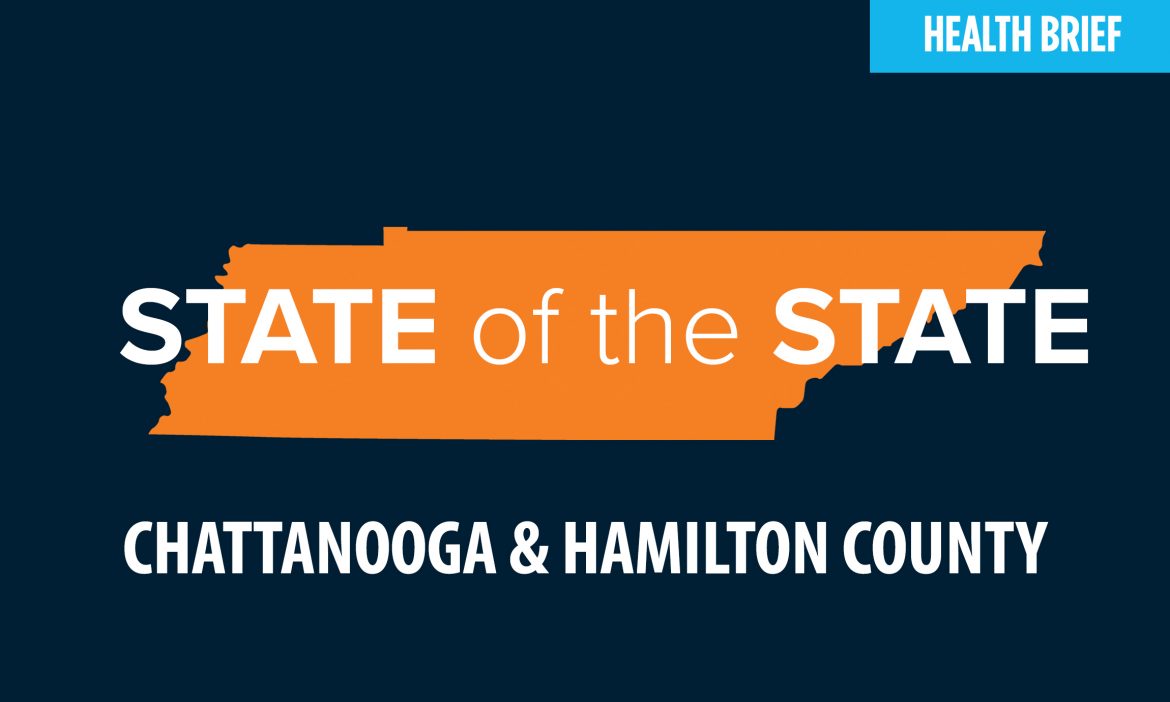County health briefs offer comprehensive information about Tennessee cities and their surrounding areas. Each county health brief is different and focuses on that county’s biggest health challenges as identified by county and city health departments. Due to the highly customized nature of this information, statistics and metrics will vary from brief to brief.
This health brief focuses on the top health priorities as identified by local experts, including the Chattanooga-Hamilton County Health Department’s community health profile.
Scroll down to read about health in Chattanooga and Hamilton County or jump to a specific section:
What are the demographics of Hamilton County?
Population
361,613 (2017)
Population Growth
Hamilton County has grown by 7.5% since 2010.
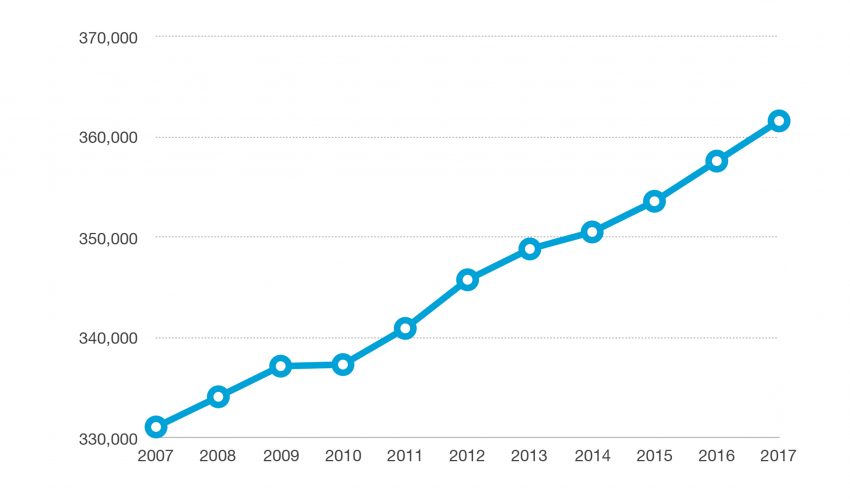
Age
The median age in Hamilton County is 39.
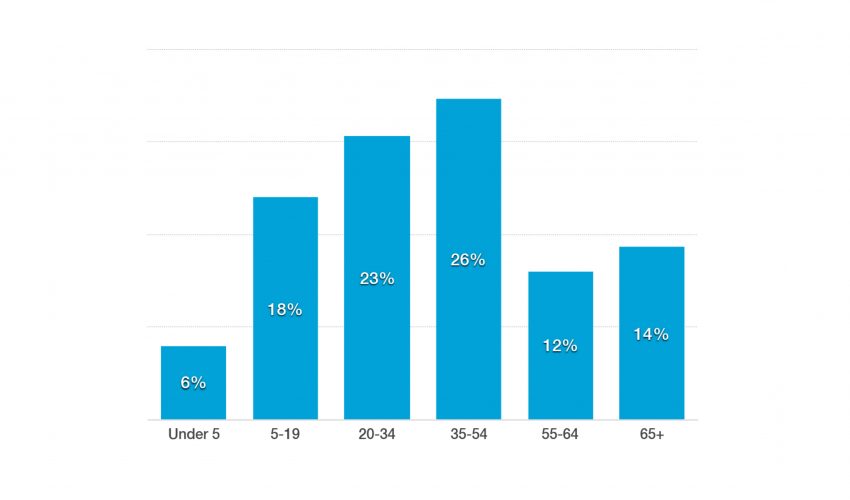
Sex
Female: 52%
Male: 48%
Race
White: 75.8%
Black: 20.1%
Hispanic: 5.4%
Asian: 2%
Multiple: 1.7%
5% of Chattanooga’s population was not born in the U.S, which is the same as Tennessee’s rate.
Life expectancy
80 years for women
75 years for men
Those numbers are:
- Higher than Tennessee’s life expectancy but
- Below the life expectancy for the U.S. as a whole, which is:
- 81 years for women
- 77 for men
Health index
Hamilton County scores 0.904 in the BlueCross Health Index where 0.867 is less healthy and 0.970 is healthier.
The index measures the impact of more than 200 common diseases and conditions on overall health and wellness by assigning each county in the United States a health metric between 0 and 1, designating the proportion of optimal health reached by the county’s population. For example, a measurement of 0.9 indicates that, on average, the population of a county is living at 90% of its optimal health. In other words, the county population could gain up to 10% in healthy lifespan by addressing the top health conditions impacting their area.
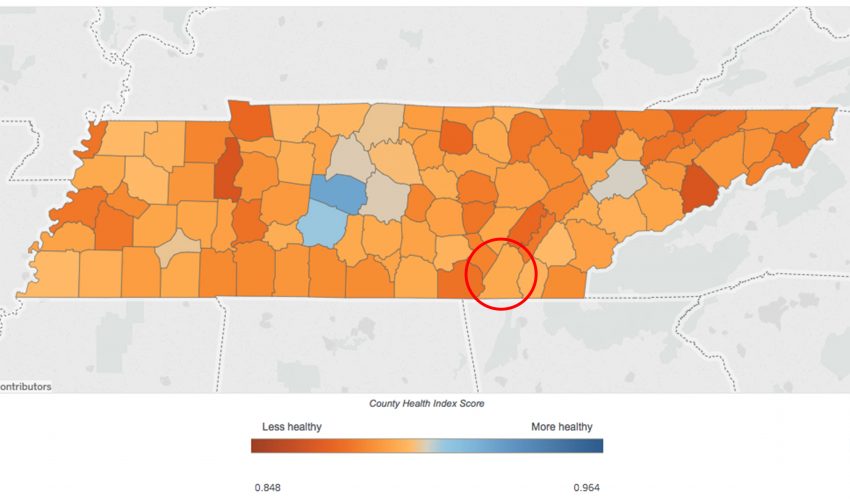
What are the most common causes of death in Chattanooga?
The top 10 causes of death in Hamilton County are:
- Heart disease
- Cancer
- Chronic lower respiratory disease
- Stroke
- Alzheimer’s disease
- Accidents
- Diabetes
- Suicide
- Nephritis (kidney disease)
- Liver disease
Leading causes of death in Hamilton County
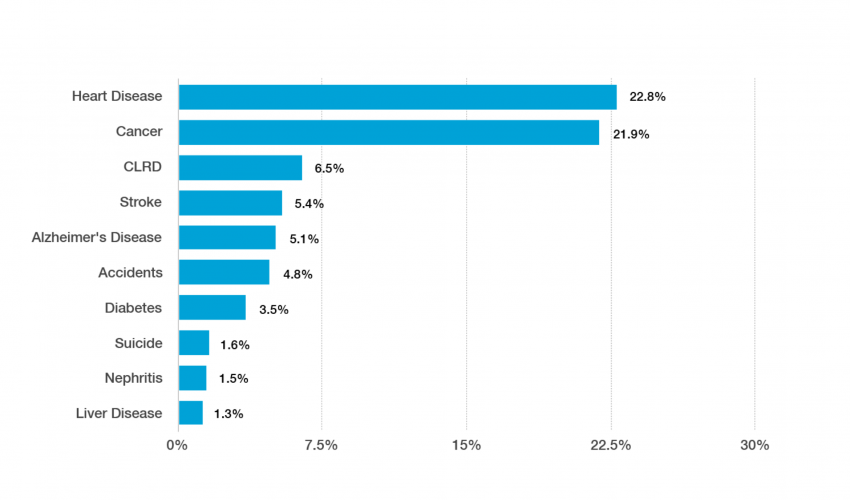
What are the most common health problems in Hamilton County?
Chronic diseases
Heart disease
The rate of heart disease deaths in Hamilton County is 352 per every 100,000 people age 35 and older, which is:
- Lower than the state rate of 393 but
- Higher than the national rate of 324.
5% of Hamilton Country adults have had a heart attack , which is:
- Lower than Tennessee’s rate of 6% and
- Higher than the national rate of 4%.
Cancer
Death from cancer is less common in Hamilton County than in the rest of the state but more common than in the U.S.
Cancer deaths in Hamilton County
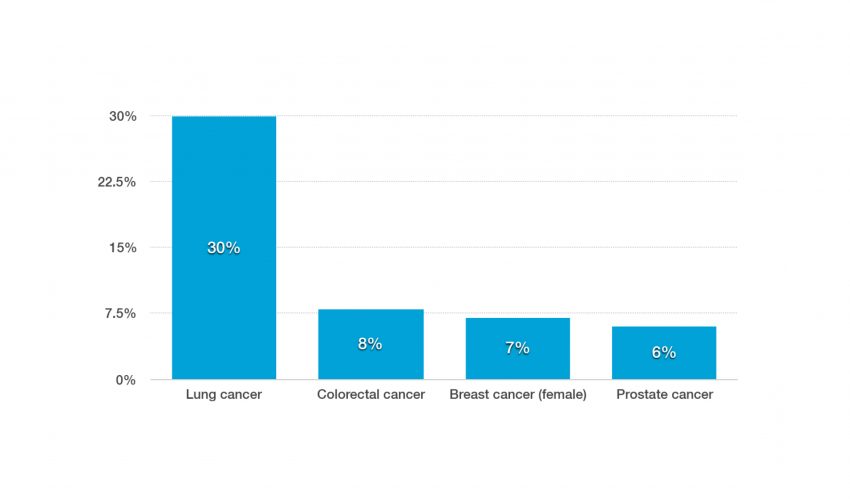
Cancer mortality rates in Hamilton County are 10% lower than Tennessee’s rates.
Stroke
5% of deaths in Hamilton County are due to stroke.
The stroke mortality rate in Hamilton County decreased by 39% between 2000 and 2013.
Chronic lower respiratory disease & asthma
Respiratory diseases — including emphysema, chronic bronchitis and asthma — are the 3rd leading cause of death in Hamilton County.
10% of Hamilton County residents have had an asthma diagnosis in their lifetime , which is:
- Comparable to Tennessee’s rate of 11% and
- Lower than the U.S. rate of 14%.
Diabetes
The rate of diagnosed diabetes in Hamilton County is 13.7%, which is:
- Higher than the Tennessee rate of 12.7% and
- Higher than the nationwide rate of 9.4%.
Obesity
31% of Hamilton County adults are obese , which is:
- The same as Tennessee’s rate and
- Higher than the U.S. rate (28%).
12% of Hamilton County adolescents are obese, compared to 15% of adolescents in Tennessee and nationwide.
Another 15% of Hamilton County adolescents are overweight, compared to 18% in Tennessee and 13% in the U.S. overall.
Physical Inactivity
69% of Hamilton County adults exercise in their leisure time, which is:
- Higher than the state rate of 66% and
- Lower than the U.S. rate of 75%
75% of adolescents in Hamilton County do not meet the nation’s physical activity guidelines for youth. The guidelines recommend 1+ hour of exercise daily.
Addiction
From 2012-14, treatment admissions in Hamilton County for alcohol, heroin, opioids, methamphetamine and other illegal substances all increased.
852 Hamilton County residents sought publicly funded treatment in 2014, compared to:
- 692 in 2013 and
- 668 in 2012.
Smoking
20% of adults in Hamilton County are current smokers, which is:
- Lower than the state average of 22%, but
- Higher than the national average of 17%.
Youth
10% of Hamilton County teens smoke cigarettes, which is slightly lower than the 11% rate in Tennessee and the U.S.
90% of all adult smokers started smoking before age 18.
22% of Tennessee high school students vape (use e-cigarettes).
Alcohol
Alcohol is the most commonly abused substance in Hamilton County, not counting tobacco.
5.6% of Hamilton County residents aged 18 and up are dependent on or abuse alcohol.
10% of Hamilton County adults report binge drinking (more than 5 drinks at one time) , which is:
- Equivalent to the rate in Tennessee and
- Significantly lower than the national rate of 17%.
18% of Hamilton County high school students reported binge drinking in the past month, which is lower than the national rate.
Drugs
More than 50% of the unintentional drug overdose deaths in Hamilton County in 2015 involved an opioid.Number of drug overdose hospital visits
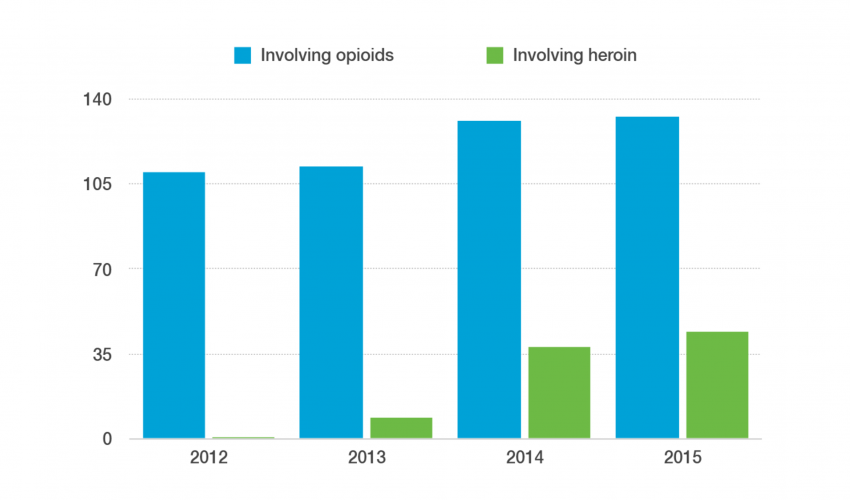
Treatment for heroin abuse doubled from 2013 to 2014.
Mental health
19% of Hamilton County adults have been told by a health care provider that they have a depressive disorder, which is comparable with state (20%) and national (18%) rates.
Suicide
Suicide is the 9th leading cause of death in Hamilton County, with a rate of 14.4 deaths for every 100,000 people. This is:
- Slightly lower than Tennessee’s rate of 14.5, and
- Higher than the national rate of 12. 6.
Suicide is on the rise across the state, particularly among youth ages 10-24.
What health disparities affect Hamilton County?
Health disparities are variations in the rate of certain diseases and disabilities between populations, usually due to socioeconomic status that presents obstacles to receiving regular health care.
Health disparities between African Americans and whites in Hamilton County exist but are narrowing in a number of areas, including:
- Deaths due to heart disease
- Infant mortality
- Teen birth rate
- Life expectancy
Infant mortality
Infant mortality is the number of children who die before turning one. In Hamilton County, the infant mortality rate is 6.7 per 1,000 births overall.
- That is slightly lower than the Tennessee rate of 6.8 and higher than the U.S. rate of 6.0.
- The rate of infant mortality for African Americans in Hamilton County is 5X higher than whites, but has been continuing on a downward trend since 2005.
Prenatal care
Prenatal care is a factor in healthy births. Mothers who don’t get prenatal care are more likely to have babies with a low birthweight and an increased risk of infant mortality.
38.3% of African-American women giving birth in Hamilton County had delayed or no prenatal care, which is higher than the same rate for white women (31.3%).
Life expectancy
Life expectancy for African Americans in 73.4 years, which is lower than for whites (77.9).
Mortality rates for a number of chronic diseases are significantly higher for African Americans than for whites in Hamilton County:
- Kidney disease – 260% higher
- Diabetes – 170% higher
- Stroke – 32% higher
- Heart disease – 19% higher
- Prostate cancer (men) – 100% higher
- Breast cancer (women) – 74% higher
What are the social determinants of health in Hamilton County?
Education
High school graduates (age 25+)
86% of Hamilton County residents age 25+ have graduated from high school, which is comparable to the state and national rates (near 85%)
Income
The median household income in Hamilton County is $49,434 which is:
- Higher than Tennessee’s ($46,574) and
- Lower than the U.S. ($55,322)
Poverty
14.8% of people in Hamilton County live in poverty, which is lower than the state rate of 17% and lower than the U.S. rate of 15.1%
19% of children live in poverty, which is a decrease from a high of 28.3% in 2011.
What is Hamilton County doing to improve community health?
The Step1 program is a countywide effort to improve eating habits and encourage physical activity among residents.
They hope to accomplish their goals through initiatives such as teaching gardens, farmers markets and opening school playgrounds to the public after school hours.
What has BlueCross done for health in Hamilton County?
The BlueCross BlueShield Health Foundation has donated or provided sponsorships for:
- $1.3 million to Count It! Lock It! Drop It! to fight addiction in Tennessee
- $1 million to support the renovation of Miller Park, a public space in Chattanooga.
- $600,00 to The Trust For Public Land to create parks and land for the public, ensuring healthy and livable communities.
- $600,000 to STORC (Solutions to Obstetrics in Rural Counties) developed and managed by Regional Obstetrical Consultants (ROC).
- $400,000 to the Helen Ross McNabb Center to improve access to mental health services in East Tennessee.
- $320,000 to La Paz in support of their Promotores de Salud (Health Promoters) resource for Latino families in Chattanooga.
- 309,238 to Girls Incorporated of Chattanooga, to support young women, and its IMPACT program that educates their peers about prenatal care and preventing infant mortality.
- $165,000 in support of the implementation of Clinica Medicos, a health clinic providing access to healthcare resources for latino families in the Chattanooga community
- $125,000 to The House of Refuge that helps men break the cycle of poverty, addiction and incarceration
- $125,000 to Signal Centers to support their Baby University program supporting and educating new parents through the critical first years of child development.
Sources
Information in this brief comes from the Hamilton County Health Department, sources linked to within this brief and from the following reports:


